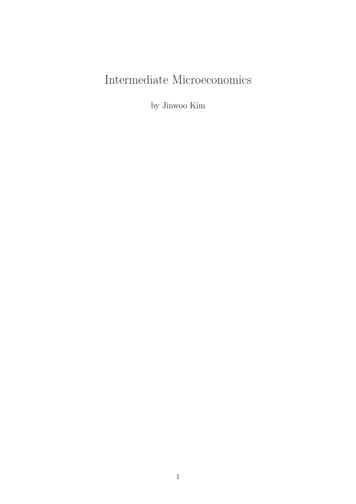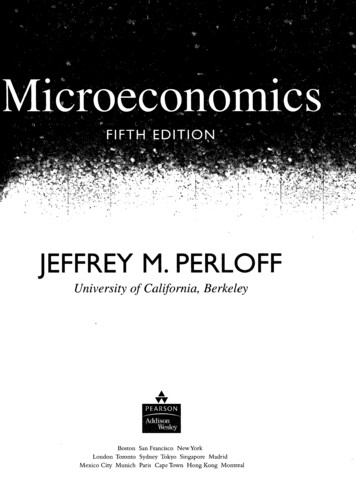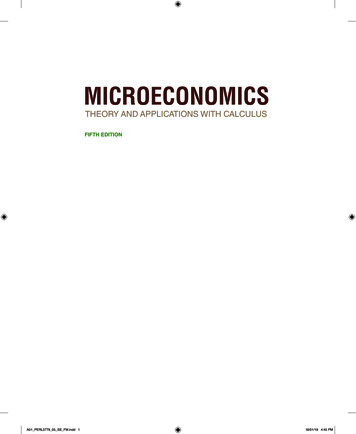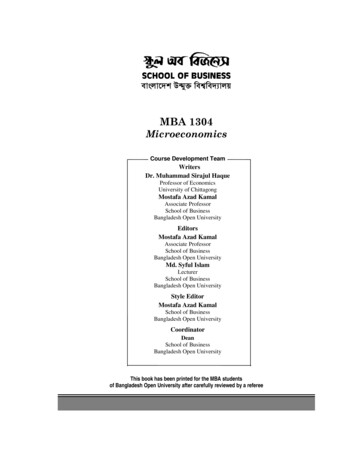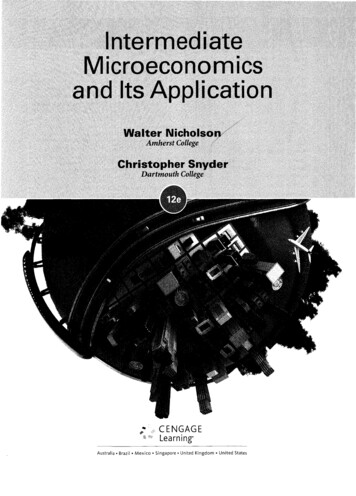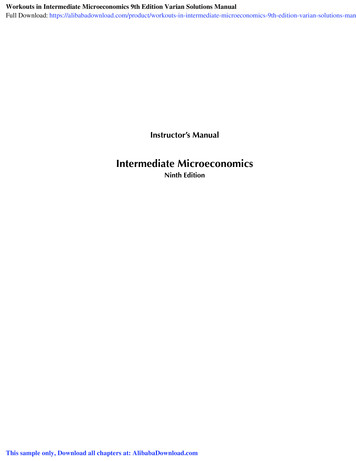
Transcription
Workouts in Intermediate Microeconomics 9th Edition Varian Solutions ManualFull Download: ions-manInstructor’s ManualIntermediate MicroeconomicsNinth EditionThis sample only, Download all chapters at: AlibabaDownload.com
Instructor’s ManualIntermediate MicroeconomicsNinth EditionInstructor’s ManualbyHal R. VarianAnswers to WorkoutsbyHal R. Varian and Theodore C. BergstromW. W. Norton & Company New York London
c 2014, 2010, 2002, 1999, 1996, 1993, 1990, 1988 by W. W. Norton & CompanyCopyright All rights reservedPrinted in the United States of AmericaTypeset in TEX by Hal R. VarianNINTH EDITIONISBN 978-0-393-93676-6W. W. Norton & Company, Inc., 500 Fifth Avenue, New York, N.Y. 10110W. W. Norton & Company, Ltd., Castle House, 75/76 Wells Street, London W1T 3QTwww.wwnorton.com1234567890
CONTENTSPart I Chapter Highlights1. The Market12. Budget Constraint43. Preferences74. Utility105. Choice136. Demand167. Revealed Preference188. Slutsky Equation219. Buying and Selling2310. Intertemporal Choice2611. Asset Markets2912. Uncertainty3113. Risky Assets3314. Consumer’s Surplus3515. Market Demand3716. Equilibrium3917. Measurement4218. Auctions4419. Technology4620. Profit Maximization4821. Cost Minimization5022. Cost Curves5223. Firm Supply5424. Industry Supply5625. Monopoly5926. Monopoly Behavior6127. Factor Markets6328. Oligopoly6529. Game Theory68
30. Game Applications7131. Behavioral Economics7532. Exchange7833. Production8134. Welfare8335. Externalities8536. Information Technology8837. Public Goods9238. Information95Part II Answers to Workouts1. The Market12. Budget Constraint53. Preferences174. Utility335. Choice496. Demand677. Revealed Preference818. Slutsky Equation979. Buying and Selling11110. Intertemporal Choice13111. Asset Markets14712. Uncertainty16113. Risky Assets17514. Consumer’s Surplus18115. Market Demand19116. Equilibrium201
17. Measurement21918. Auctions22119. Technology23920. Profit Maximization25121. Cost Minimization26722. Cost Curves27923. Firm Supply28524. Industry Supply29525. Monopoly31126. Monopoly Behavior31727. Factor Markets33128. Oligopoly33529. Game Theory35130. Game Applications36531. Behavioral Economics38132. Exchange39133. Production40734. Welfare41735. Externalities42736. Information Technology43937. Public Goods45538. Asymmetric Information469
Chapter 1 1Chapter 1The MarketThis chapter was written so I would have something to talk about on the firstday of class. I wanted to give students an idea of what economics was all about,and what my lectures would be like, and yet not have anything that was reallycritical for the course. (At Michigan, students are still shopping around on thefirst day, and a good number of them won’t necessarily be at the lecture.)I chose to discuss a housing market since it gives a way to describe a numberof economic ideas in very simple language and gives a good guide to what liesahead. In this chapter I was deliberately looking for surprising results—analyticinsights that wouldn’t arise from “just thinking” about a problem. The twomost surprising results that I presented are the condominium example and thetax example in Section 1.6. It is worth emphasizing in class just why these resultsare true, and how they illustrate the power of economic modeling.It also makes sense to describe their limitations. Suppose that every condominium conversion involved knocking out the walls and creating two apartments. Then what would happen to the price of apartments? Suppose that thecondominiums attracted suburbanites who wouldn’t otherwise consider rentingan apartment. In each of these cases, the price of remaining apartments wouldrise when condominium conversion took place.The point of a simple economic model of the sort considered here is to focusour thoughts on what the relevant effects are, not to come to a once-and-for-allconclusion about the urban housing market. The real insight that is offered bythese examples is that you have to consider both the supply and the demandside of the apartment market when you analyze the impact of this particularpolicy.The only concept that the students seem to have trouble with in this chapteris the idea of Pareto efficiency. I usually talk about the idea a little more thanis in the book and rephrase it a few times. But then I tell them not to worryabout it too much, since we’ll look at it in great detail later in the course.The workbook problems here are pretty straightforward. The biggest problemis getting the students to draw the true (discontinuous) demand curve, as inFigure 1.1, rather than just to sketch in a downward-sloping curve as in Figure1.2. This is a good time to emphasize to the students that when they are givennumbers describing a curve, they have to use the numbers—they can’t just sketchin any old shape.
2 Chapter HighlightsThe MarketA. Example of an economic model — the market for apartments1. models are simplifications of reality2. for example, assume all apartments are identical3. some are close to the university, others are far away4. price of outer-ring apartments is exogenous — determined outside themodel5. price of inner-ring apartments is endogenous — determined within themodelB. Two principles of economics1. optimization principle — people choose actions that are in their interest2. equilibrium principle — people’s actions must eventually be consistentwith each otherC. Constructing the demand curve1. line up the people by willingness-to-pay. See Figure 1.1.2. for large numbers of people, this is essentially a smooth curve as in Figure1.2.D. Supply curve1. depends on time frame2. but we’ll look at the short run — when supply of apartments is fixed.E. Equilibrium1. when demand equals supply2. price that clears the marketF. Comparative statics1. how does equilibrium adjust when economic conditions change?2. “comparative” — compare two equilibria3. “statics” — only look at equilibria, not at adjustment4. example — increase in supply lowers price; see Figure 1.5.5. example — create condos which are purchased by renters; no effect onprice; see Figure 1.6.G. Other ways to allocate apartments1. discriminating monopolist2. ordinary monopolist3. rent controlH. Comparing different institutions1. need a criterion to compare how efficient these different allocation methodsare.2. an allocation is Pareto efficient if there is no way to make some groupof people better off without making someone else worse off.3. if something is not Pareto efficient, then there is some way to make somepeople better off without making someone else worse off.4. if something is not Pareto efficient, then there is some kind of “waste” inthe system.I. Checking efficiency of different methods1. free market — efficient2. discriminating monopolist — efficient3. ordinary monopolist — not efficient4. rent control — not efficient
Chapter 1 3J. Equilibrium in long run1. supply will change2. can examine efficiency in this context as well
4 Chapter HighlightsChapter 2Budget ConstraintMost of the material here is pretty straightforward. Drive home the formulafor the slope of the budget line, emphasizing the derivation on page 23. Trysome different notation to make sure that they see the idea of the budget line,and don’t just memorize the formulas. In the workbook, we use a number ofdifferent choices of notation for precisely this reason. It is also worth pointingout that the slope of a line depends on the (arbitrary) choice of which variableis plotted on the vertical axis. It is surprising how often confusion arises on thispoint.Students sometimes have problems with the idea of a numeraire good. Theyunderstand the algebra, but they don’t understand when it would be used. Onenice example is in foreign currency exchange. If you have English pounds andAmerican dollars, then you can measure the total wealth that you have in eitherdollars or pounds by choosing one or the other of the two goods as numeraire.In the workbook, students sometimes get thrown in exercises where one ofthe goods has a negative price, so the budget line has a positive slope. Thiscomes from trying to memorize formulas and figures rather than thinking aboutthe problem. This is a good exercise to go over in order to warn students aboutthe dangers of rote learning!Budget ConstraintA. Consumer theory: consumers choose the best bundles of goods they canafford.1. this is virtually the entire theory in a nutshell2. but this theory has many surprising consequencesB. Two parts to theory1. “can afford” — budget constraint2. “best” — according to consumers’ preferences
Chapter 2 5C. What do we want to do with the theory?1. test it — see if it is adequate to describe consumer behavior2. predict how behavior changes as economic environment changes3. use observed behavior to estimate underlying valuesa) cost-benefit analysisb) predicting impact of some policyD. Consumption bundle1. (x1 , x2 ) — how much of each good is consumed2. (p1 , p2 ) — prices of the two goods3. m — money the consumer has to spend4. budget constraint: p1 x1 p2 x2 m5. all (x1 , x2 ) that satisfy this constraint make up the budget set of theconsumer. See Figure 2.1.E. Two goods1. theory works with more than two goods, but can’t draw pictures.2. often think of good 2 (say) as a composite good, representing money tospend on other goods.3. budget constraint becomes p1 x1 x2 m.4. money spent on good 1 (p1 x1 ) plus the money spent on good 2 (x2 ) hasto be less than or equal to the amount available (m).F. Budget line1. p1 x1 p2 x2 m2. also written as x2 m/p2 (p1 /p2 )x1 .3. budget line has slope of p1 /p2 and vertical intercept of m/p2 .4. set x1 0 to find vertical intercept (m/p2 ); set x2 0 to find horizontalintercept (m/p1 ).5. slope of budget line measures opportunity cost of good 1 — how much ofgood 2 you must give up in order to consume more of good 1.G. Changes in budget line1. increasing m makes parallel shift out. See Figure 2.2.2. increasing p1 makes budget line steeper. See Figure 2.3.3. increasing p2 makes budget line flatter4. just see how intercepts change5. multiplying all prices by t is just like dividing income by t6. multiplying all prices and income by t doesn’t change budget linea) “a perfectly balanced inflation doesn’t change consumption possibilities”H. The numeraire1. can arbitrarily assign one price a value of 1 and measure other price relativeto that2. useful when measuring relative prices; e.g., English pounds per dollar, 1987dollars versus 1974 dollars, etc.I. Taxes, subsidies, and rationing1. quantity tax — tax levied on units bought: p1 t2. value tax — tax levied on dollars spent: p1 τ p1 . Also known as advalorem tax3. subsidies — opposite of a taxa) p1 sb) (1 σ)p1
6 Chapter Highlights4. lump sum tax or subsidy — amount of tax or subsidy is independent ofthe consumer’s choices. Also called a head tax or a poll tax5. rationing — can’t consume more than a certain amount of some goodJ. Example — food stamps1. before 1979 was an ad valorem subsidy on fooda) paid a certain amount of money to get food stamps which were worthmore than they costb) some rationing component — could only buy a maximum amount offood stamps2. after 1979 got a straight lump-sum grant of food coupons. Not the sameas a pure lump-sum grant since could only spend the coupons on food.
Chapter 3 7Chapter 3PreferencesThis chapter is more abstract and therefore needs somewhat more motivationthan the previous chapters. It might be a good idea to talk about relations ingeneral before introducing the particular idea of preference relations. Try therelations of “taller,” and “heavier,” and “taller and heavier.” Point out that“taller and heavier” isn’t a complete relation, while the other two are. Thisgeneral discussion can motivate the general idea of preference relations.Make sure that the students learn the specific examples of preferences suchas perfect substitutes, perfect complements, etc. They will use these examplesmany, many times in the next few weeks!When describing the ideas of perfect substitutes, emphasize that the definingcharacteristic is that the slope of the indifference curves is constant, not that itis 1. In the text, I always stick with the case where the slope is 1, but inthe workbook, we often treat the general case. The same warning goes with theperfect complements case. I work out the symmetric case in the text and try toget the students to do the asymmetric case in the workbook.The definition of the marginal rate of substitution is fraught with “signconfusion.” Should the M RS be defined as a negative or a positive number? I’vechosen to give the M RS its natural sign in the book, but I warn the students thatmany economists tend to speak of the M RS in terms of absolute value. Example:diminishing marginal rate of substitution refers to a situation where the absolutevalue of the M RS decreases as we move along an indifference curve. The actualvalue of the M RS (a negative number) is increasing in this movement!Students often begin to have problems with the workbook exercises here.The first confusion they have is that they get mixed up about the idea thatindifference curves measure the directions where preferences are constant, andinstead draw lines that indicate the directions that preferences are increasing.The second problem that they have is in knowing when to draw just arbitrarycurves that qualitatively depict some behavior or other, and when to draw exactshapes.Try asking your students to draw their indifference curves between five dollarbills and one dollar bills. Offer to trade with them based on what they draw. Inaddition to getting them to think, this is a good way to supplement your facultysalary.
8 Chapter HighlightsPreferencesA. Preferences are relationships between bundles.1. if a consumer would choose bundle (x1 , x2 ) when (y1 , y2 ) is available, thenit is natural to say that bundle (x1 , x2 ) is preferred to (y1 , y2 ) by thisconsumer.2. preferences have to do with the entire bundle of goods, not with individualgoods.B. Notation1. (x1 , x2 ) (y1 , y2 ) means the x-bundle is strictly preferred to the ybundle2. (x1 , x2 ) (y1 , y2 ) means that the x-bundle is regarded as indifferent tothe y-bundle3. (x1 , x2 ) (y1 , y2 ) means the x-bundle is at least as good as (preferredto or indifferent to) the y-bundleC. Assumptions about preferences1. complete — any two bundles can be compared2. reflexive — any bundle is at least as good as itself3. transitive — if X Y and Y Z, then X Za) transitivity necessary for theory of optimal choiceD. Indifference curves1. graph the set of bundles that are indifferent to some bundle. See Figure3.1.2. indifference curves are like contour lines on a map3. note that indifference curves describing two distinct levels of preferencecannot cross. See Figure 3.2.a) proof — use transitivityE. Examples of preferences1. perfect substitutes. Figure 3.3.a) red pencils and blue pencils; pints and quartsb) constant rate of trade-off between the two goods2. perfect complements. Figure 3.4.a) always consumed togetherb) right shoes and left shoes; coffee and cream3. bads. Figure 3.5.4. neutrals. Figure 3.6.5. satiation or bliss point Figure 3.7.F. Well-behaved preferences1. monotonicity — more of either good is bettera) implies indifference curves have negative slope. Figure 3.9.2. convexity — averages are preferred to extremes. Figure 3.10.a) slope gets flatter as you move further to rightb) example of non-convex preferencesG. Marginal rate of substitution1. slope of the indifference curve2. M RS Δx2 /Δx1 along an indifference curve. Figure 3.11.3. sign problem — natural sign is negative, since indifference curves willgenerally have negative slope4. measures how the consumer is willing to trade off consumption of good 1for consumption of good 2. Figure 3.12.
Chapter 3 95. measures marginal willingness to pay (give up)a) not the same as how much you have to payb) but how much you would be willing to pay
10 Chapter HighlightsChapter 4UtilityIn this chapter, the level of abstraction kicks up another notch. Students oftenhave trouble with the idea of utility. It is sometimes hard for trained economiststo sympathize with them sufficiently, since it seems like such an obvious notionto us.Here is a way to approach the subject. Suppose that we return to the idea ofthe “heavier than” relation discussed in the last chapter. Think of having a bigbalance scale with two trays. You can put someone on each side of the balancescale and see which person is heavier, but you don’t have any standardizedweights. Nevertheless you have a way to determine whether x is heavier than y.Now suppose that you decide to establish a scale. You get a bunch ofstones, check that they are all the same weight, and then measure the weight ofindividuals in stones. It is clear that x is heavier than y if x’s weight in stonesis heavier than y’s weight in stones.Somebody else might use different units of measurements—kilograms, pounds,or whatever. It doesn’t make any difference in terms of deciding who is heavier.At this point it is easy to draw the analogy with utility—just as pounds givea way to represent the “heavier than” order numerically, utility gives a wayto represent the preference order numerically. Just as the units of weight arearbitrary, so are the units of utility.This analogy can also be used to explore the concept of a positive monotonictransformation, a concept that students have great trouble with. Tell them thata monotonic transformation is just like changing units of measurement in theweight example.However, it is also important for students to understand that nonlinearchanges of units are possible. Here is a nice example to illustrate this. Supposethat wood is always sold in piles shaped like cubes. Think of the relation “onepile has more wood than another.” Then you can represent this relation bylooking at the measure of the sides of the piles, the surface area of the piles, orthe volume of the piles. That is, x, x2 , or x3 gives exactly the same comparisonbetween the piles. Each of these numbers is a different representation of theutility of a cube of wood.Be sure to go over carefully the examples here. The Cobb-Douglas exampleis an important one, since we use it so much in the workbook. Emphasize thatit is just a nice functional form that gives convenient expressions. Be sure to
Chapter 4 11elaborate on the idea that xa1 xb2 is the general form for Cobb-Douglas preferences,but various monotonic transformations (e.g., the log) can make it look quitedifferent. It’s a good idea to calculate the M RS for a few representations ofthe Cobb-Douglas utility function in class so that people can see how to dothem and, more importantly, that the M RS doesn’t change as you change therepresentation of utility.The example at the end of the chapter, on commuting behavior, is a verynice one. If you present it right, it will convince your students that utility is anoperational concept. Talk about how the same methods can be used in marketingsurveys, surveys of college admissions, etc.The exercises in the workbook for this chapter are very important since theydrive home the ideas. A lot of times, students think that they understand somepoint, but they don’t, and these exercises will point that out to them. It isa good idea to let the students discover for themselves that a sure-fire way totell whether one utility function represents the same preferences as another is tocompute the two marginal rate of substitution functions. If they don’t get thisidea on their own, you can pose it as a question and lead them to the answer.UtilityA. Two ways of viewing utility1. old waya) measures how “satisfied” you are1) not operational2) many other problems2. new waya) summarizes preferencesb) a utility function assigns a number to each bundle of goods so that morepreferred bundles get higher numbersc) that is, u(x1 , x2 ) u(y1 , y2 ) if and only if (x1 , x2 ) (y1 , y2 )d) only the ordering of bundles counts, so this is a theory of ordinalutilitye) advantages1) operational2) gives a complete theory of demandB. Utility functions are not unique1. if u(x1 , x2 ) is a utility function that represents some preferences, and f (·) isany increasing function, then f (u(x1 , x2 )) represents the same preferences2. why? Because u(x1 , x2 ) u(y1 , y2 ) only if f (u(x1 , x2 )) f (u(y1 , y2 ))3. so if u(x1 , x2 ) is a utility function then any positive monotonic transformation of it is also a utility function that represents the same preferencesC. Constructing a utility function1. can do it mechanically using the indifference curves. Figure 4.2.2. can do it using the “meaning” of the preferencesD. Examples1. utility to indifference curvesa) easy — just plot all points where the utility is constant2. indifference curves to utility3. examplesa) perfect substitutes — all that matters is total number of pencils, sou(x1 , x2 ) x1 x2 does the trick
12 Chapter Highlights1) can use any monotonic transformation of this as well, such aslog (x1 x2 )b) perfect complements — what matters is the minimum of the left andright shoes you have, so u(x1 , x2 ) min{x1 , x2 } worksc) quasilinear preferences — indifference curves are vertically parallel.Figure 4.4.1) utility function has form u(x1 , x2 ) v(x1 ) x2d) Cobb-Douglas preferences. Figure 4.5.1) utility has form u(x1 , x2 ) xb1 xc21bc2) convenient to take transformation f (u) u b c and write x1b c x2b c3) or xa1 x1 a, where a b/(b c)2E. Marginal utility1. extra utility from some extra consumption of one of the goods, holding theother good fixed2. this is a derivative, but a special kind of derivative — a partial derivative3. this just means that you look at the derivative of u(x1 , x2 ) keeping x2 fixed— treating it like a constant4. examplesa) if u(x1 , x2 ) x1 x2 , then M U1 u/ x1 1, then M U1 u/ x1 axa 1x1 ab) if u(x1 , x2 ) xa1 x1 a2125. note that marginal utility depends on which utility function you choose torepresent preferencesa) if you multiply utility times 2, you multiply marginal utility times 2b) thus it is not an operational conceptc) however, M U is closely related to M RS, which is an operational concept6. relationship between M U and M RSa) u(x1 , x2 ) k, where k is a constant, describes an indifference curveb) we want to measure slope of indifference curve, the M RSc) so consider a change (dx1 , dx2 ) that keeps utility constant. ThenM U1 dx1 M U2 dx2 0 u udx1 dx2 0 x1 x2d) henceM U1dx2 dx1M U2e) so we can compute M RS from knowing the utility functionF. Example1. take a bus or take a car to work?2. let x1 be the time of taking a car, y1 be the time of taking a bus. Let x2be cost of car, etc.3. suppose utility function takes linear form U (x1 , . . . , xn ) β1 x1 . . . βn xn4. we can observe a number of choices and use statistical techniques toestimate the parameters βi that best describe choices5. one study that did this could forecast the actual choice over 93% of thetime6. once we have the utility function we can do many things with it:a) calculate the marginal rate of substitution between two characteristics1) how much money would the average consumer give up in order toget a shorter travel time?b) forecast consumer response to proposed changesc) estimate whether proposed change is worthwhile in a benefit-cost sense
Chapter 5 13Chapter 5ChoiceThis is the chapter where we bring it all together. Make sure that studentsunderstand the method of maximization and don’t just memorize the variousspecial cases. The problems in the workbook are designed to show the futility ofmemorizing special cases, but often students try it anyway.The material in Section 5.4 is very important—I introduce it by saying “Whyshould you care that the M RS equals the price ratio?” The answer is that thisallows economists to determine something about peoples’ trade-offs by observingmarket prices. Thus it allows for the possibility of benefit-cost analysis.The material in Section 5.5 on choosing taxes is the first big non-obviousresult from using consumer theory ideas. I go over it very carefully, to makesure that students understand the result, and emphasize how this analysisuses the techniques that we’ve developed. Pound home the idea that theanalytic techniques of microeconomics have a big payoff—they allow us to answerquestions that we wouldn’t have been able to answer without these techniques.If you are doing a calculus-based course, be sure to spend some time on theappendix to this chapter. Emphasize that to solve a constrained maximizationproblem, you must have two equations. One equation is the constraint, and oneequation is the optimization condition. I usually work a Cobb-Douglas and aperfect complements problem to illustrate this. In the Cobb-Douglas case, theoptimization condition is that the M RS equals the price ratio. In the perfectcomplements case, the optimization condition is that the consumer chooses abundle at the corner.ChoiceA. Optimal choice1. move along the budget line until preferred set doesn’t cross the budget set.Figure 5.1.2. note that tangency occurs at optimal point — necessary condition foroptimum. In symbols: M RS price ratio p1 /p2 .a) exception — kinky tastes. Figure 5.2.b) exception — boundary optimum. Figure 5.3.3. tangency is not sufficient. Figure 5.4.a) unless indifference curves are convex.
14 Chapter Highlightsb) unless optimum is interior.4. optimal choice is demanded bundlea) as we vary prices and income, we get demand functions.b) want to study how optimal choice — the demanded bundle – changesas price and income changeB. Examples1. perfect substitutes: x1 m/p1 if p1 p2 ; 0 otherwise. Figure 5.5.2. perfect complements: x1 m/(p1 p2 ). Figure 5.6.3. neutrals and bads: x1 m/p1 .4. discrete goods. Figure 5.7.a) suppose good is either consumed or notb) then compare (1, m p1 ) with (0, m) and see which is better.5. concave preferences: similar to perfect substitutes. Note that tangencydoesn’t work. Figure 5.8.6. Cobb-Douglas preferences: x1 am/p1 . Note constant budget shares, a budget share of good 1.C. Estimating utility function1. examine consumption data2. see if you can “fit” a utility function to it3. e.g., if income shares are more or less constant, Cobb-Douglas does a goodjob4. can use the fitted utility function as guide to policy decisions5. in real life more complicated forms are used, but basic idea is the sameD. Implications of M RS condition1. why do we care that M RS price ratio?2. if everyone faces the same prices, then everyone has the same local trade-offbetween the two goods. This is independent of income and tastes.3. since everyone locally values the trade-off the same, we can make policyjudgments. Is it worth sacrificing one good to get more of the other? Pricesserve as a guide to relative marginal valuations.E. Application — choosing a tax. Which is better, a commodity tax or an incometax?1. can show an income tax is always better in the sense that given anycommodity tax, there is an income tax that makes the consumer betteroff. Figure 5.9.2. outline of argument:a) original budget constraint: p1 x1 p2 x2 mb) budget constraint with tax: (p1 t)x1 p2 x2 mc) optimal choice with tax: (p1 t)x 1 p2 x 2 md) revenue raised is tx 1e) income tax that raises same amount of revenue leads to budget constraint: p1 x1 p2 x2 m tx 11) this line has same slope as original budget line2) also passes through (x 1 , x 2 )3) proof: p1 x 1 p2 x 2 m tx 14) this means that (x 1 , x 2 ) is affordable under the income tax, so theoptimal choice under the income tax must be even better than(x 1 , x 2 )3. caveatsa) only applies for one consumer — for each consumer there is an incometax that is better
Chapter 5 15b) income is exogenous — if income responds to tax, problemsc) no supply response — only looked at demand sideF. Appendix — solving for the optimal choice1. calculus problem — constrained maximization2. max u(x1 , x2 ) s.t. p1 x1 p2 x2 m3. method 1: write down M RS p1 /p2 and budget constraint and solve.4. method 2: substitute from constraint into objective function and solve.5. method 3: Lagrange’s methoda) write Lagrangian: L u(x1 , x2 ) λ(p1 x1 p2 x2 m).b) differentiate with respect to x1 , x2 , λ.c) solve equations.6. example 1: Cobb-Douglas problem in book7. example 2: quasilinear preferencesa) max u(x1 ) x2 s.t. p1 x1 x2 mb) easiest to substitute, but works each way
16 Chapter HighlightsChapter 6DemandThis is a very important chapter, since it unifies all the material in theprevious chapter. It is also the chapter that separates the sheep from the goats.If the student has been paying attention for the previous 5 chapters and has beenreligiously doing the homework, then it is fairly easy to handle this chapter. Alas,I have often found that students have developed a false sense of confidence afterseeing budget constraints, drift through the discussions of preference and utility,and come crashing down to earth at Chapter 6.So, the first thing to do is to get them to review the previous chapters.Emphasize how each chapter builds on the previous chapters, and how Chapter 6represents a culmination of this building. In turn Chapter 6 is a foundation forfurther analysis, and must be mastered in order to continue.Part of the problem is that there is a large number of new concepts in thischapter: offer curves, demand curves, Engel curves, inferior goods, Giffen goods,etc. A list of these ideas along with their definitions and page references is oftenhelpful just for getting the concepts down pat.If you are doing a calculus-based course, the material in the appendix onquasilinear preferences is quite important. We will refer to this treatment lateron when we discuss consumer’s surplus, so it is a good idea to go through itcarefully now.Students us
Instructor's Manual Intermediate Microeconomics Ninth Edition Instructor's Manual by Hal R. Varian Answers to Workouts by Hal R. Varian and Theodore C. Bergstrom W. W. Norton & Company New York London






